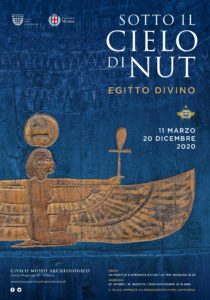The Amduat papyrus on loan to the Milan Archaeological Museum
- 01, 17, 2022
- Category EnglishNews, Museo di Archeologia, Sistema museale d'Ateneo di Pavia
- Posted By valeria parisi

The Museum of Archaeology of the University of Pavia owns a precious papyrus from the Book of Amduat, which has recently been loaned to the Civic Archaeological Museum of Milan for the exhibition Sotto il cielo di Nut. Divine Egypt, 11 March 2020-20 December 2020. The artefacts selected for the exhibition come from the Egyptian collection of the Civico Museo Archeologico in Milan and from important Italian museums: Museo Egizio in Turin, Museo Archeologico Nazionale in Florence, Museo Civico Archeologico in Bologna, Civico Museo di Antichità “J.J.Winckelmann” in Trieste, Museo di Archeologia dell’Università di Pavia.
Due to the health emergency, the opening of the exhibition has been postponed until a later date.
The papyrus scroll was donated to the University of Pavia in 1825 by Eduard Rüppell, a naturalist and zoologist born in Frankfurt am Main. He studied at the University of Pavia and travelled extensively in North East Africa and the Middle East, collecting natural and archaeological finds.
The scroll has been preserved in two fragments that are now usable, unrolled and arranged in an under-glass frame. It illustrates with drawings and explanatory hieroglyphics extracts from the Twelfth Hour of Night, the boat journey from sunset to sunrise of the sun god Ra, accompanied by other deities, the sacred scarab and threatened by Apopi, the giant serpent god of darkness. According to the religion of the ancient Egyptians, creation is conceived as a generative process that repeats itself continuously, at the basis of which is the daily cycle of the sun. The sun dies every evening to be reborn every morning, born again by the sky goddess Nut, after having made, in order to regenerate itself, a nocturnal journey into the dark underworld, dominated by potentially destructive forces.
This type of papyrus scroll was placed in tombs next to the sarcophagi of mummies to accompany the deceased on the journey to the beyond, symbolically represented in the papyrus itself by the journey of the sun god.
Unfortunately we do not know the name of the deceased that this papyrus accompanied on the afterlife journey, nor do we know the precise location of its discovery, but it is supposed to come from the necropolis of Thebes and is datable to the second part of the New Kingdom (1550-1069 BC).
We will announce the new opening date of the exhibition on this website as soon as it is available.
Due to the health emergency, the opening of the exhibition has been postponed until a later date.
The papyrus scroll was donated to the University of Pavia in 1825 by Eduard Rüppell, a naturalist and zoologist born in Frankfurt am Main. He studied at the University of Pavia and travelled extensively in North East Africa and the Middle East, collecting natural and archaeological finds.
The scroll has been preserved in two fragments that are now usable, unrolled and arranged in an under-glass frame. It illustrates with drawings and explanatory hieroglyphics extracts from the Twelfth Hour of Night, the boat journey from sunset to sunrise of the sun god Ra, accompanied by other deities, the sacred scarab and threatened by Apopi, the giant serpent god of darkness. According to the religion of the ancient Egyptians, creation is conceived as a generative process that repeats itself continuously, at the basis of which is the daily cycle of the sun. The sun dies every evening to be reborn every morning, born again by the sky goddess Nut, after having made, in order to regenerate itself, a nocturnal journey into the dark underworld, dominated by potentially destructive forces.
This type of papyrus scroll was placed in tombs next to the sarcophagi of mummies to accompany the deceased on the journey to the beyond, symbolically represented in the papyrus itself by the journey of the sun god.
Unfortunately we do not know the name of the deceased that this papyrus accompanied on the afterlife journey, nor do we know the precise location of its discovery, but it is supposed to come from the necropolis of Thebes and is datable to the second part of the New Kingdom (1550-1069 BC).
We will announce the new opening date of the exhibition on this website as soon as it is available.

